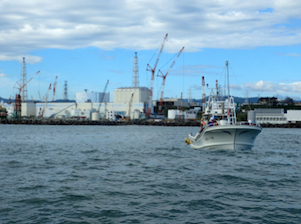First factor: Earthquake and tsunami
As the 9.0 magnitude earthquake hit the Japanese shore, the reactors of the Fukushima Daiichi nuclear power plant shut down automatically to control the nuclear fission. The electrical lines collapsed, but the plant responded as designed, and the earthquake itself did not cause any other problems. The tsunami it triggered, however, did.
“The reactors were robust, seismically speaking,” said Gustavo Caruso, Director of the IAEA’s Office of Safety and Security Coordination. “But they were vulnerable to the high tsunami waves.”
When the flooding hit, the ‘tsunami walls’ made to protect the plant from such events were too low to prevent the sea water from entering the plant. The water’s strength destroyed some of the structures, and entered the diesel generator room — which was built lower and at a closer distance to sea level than other plants in Japan — affecting Units 1, 2 and 3.
“In spite of all the efforts that were made, and in spite of the nuclear power plant structure resisting the earthquake, the tsunami was the main cause that affected the plant’s defence in depth design, bypassing several safety layers and leading to core melts in Units 1, 2 and 3,” Caruso said.
Second factor: Design weaknesses
“The diesel generators are essential for maintaining the plant’s electrical supplies in emergency situations,” said Pal Vincze, Head of the Nuclear Power Engineering Section at the IAEA. “They were drowned.”
If the diesel generator is affected, special batteries can be used to generate electricity, but these have a limited capacity, and, in the case of Fukushima Daiichi, some were also flooded. “In Japan, they put up a heroic fight to get the electrical systems up and running again, but it wasn’t enough,” Vincze added.
Without functioning instrumentation and control systems, or electrical power or cooling capabilities, the overheated fuel melted, sank to the bottom of the reactors, and breached the reactor vessels, leading to three meltdowns. In addition, data logs and vital systems operated by safety parameters were also flooded, which meant that there was no way for the operator to monitor what was going on inside the reactors.
Third factor: Shortcomings in safety culture
As stated in the IAEA report on the Fukushima Daiichi accident, “a major factor that contributed to the accident was the widespread assumption in Japan that its nuclear power plants were so safe that an accident of this magnitude was simply unthinkable. This assumption was accepted by nuclear power plant operators and was not challenged by regulators or by the Government. As a result, Japan was not sufficiently prepared for a severe nuclear accident in March 2011.”
This complacency amounted to a ‘basic assumption’ that the plant could cope with anything, whether it was related to technology or nature. When planning, designing and constructing the plant, experts did not properly take into consideration past tsunami experiences.
“There was a belief that the plans were safe enough, and that they were fully prepared to face extreme external events,” Caruso said. “It must be noted that the combination of an earthquake of this magnitude and a tsunami is extremely rare, but unfortunately this is what happened.”
This basic assumption, combined with a lack of adequate training among operators in accident management and a lack of sufficient compensatory measures against tsunamis, are what led to the accident, Caruso added.
Fourth factor: Gaps in the regulatory system
The Fukushima Daiichi accident exposed certain weaknesses in Japan’s regulatory framework. According to the Report, responsibilities had been divided among a number of bodies, and it had not always been clear where authority lay. The Report also points out that some of the IAEA safety recommendations made to the regulator had not been implemented, and some international standards had not been met.
It must be said, Caruso concluded, that in spite of the core damage that led to the release of radioactive material into the environment, no health effects could be attributable to radiation, because “based on dose data, and environmental and personal monitoring, the effective doses incurred by members of the public were very low and generally comparable with the range of effective doses incurred due to global levels of natural background radiation.”


